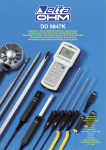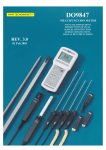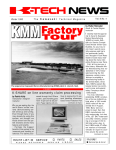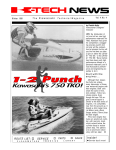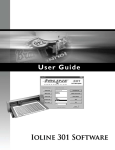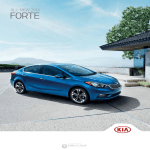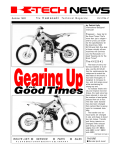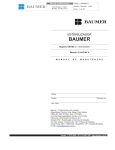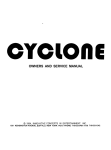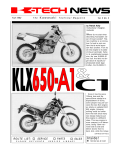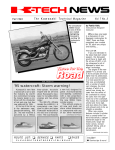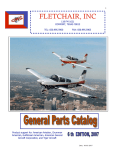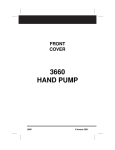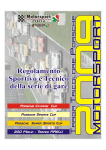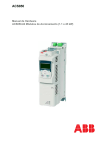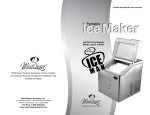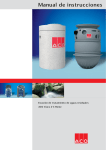Download K-Tech News Vol.7 No.1
Transcript
Spring 1994 The Kawasaki Technical Magazine Vol. 7 No. 1 by Patrick Kelly Instructional Designer/ Instructor If you followed personal watercraft racing this past season, you couldn’t have missed it. The competition probably wishes they had never seen it. “It” was the Kawasaki Super Sport Xi modified by Performance Jet Ski and ridden to the IJSBA World and National Pro Runabout championships by John Stevens. Now, a version of this machine is available to the serious JET SKI® watercraft enthusiast. Introducing the JH750-D1 or, simply, the XiR. The hull The XiR is based on our Super Sport Xi, with a few important differences. One of the biggest differences is the hull: The XiR hull is virtually identical to the one used on John Stevens’ championshipwinning boat. It differs from the Xi hull from the bond line down. There is now an extra strake on each side of the hull bottom. This extra strake helps improve the XiR’s cornering as well as its straight line abilities. Also for improved cornering and stability, there are longer sponsons on the XiR hull. These additions are especially effective in the rough water conditions found in competition. CONTINUED ON PAGE 2 ROUTE LIST: o SERVICE o PARTS o SALES P L E A S ER E T U R NT OS E R V I C EL I B R A R Y Inside! n Service tips & more! S H O P The XiR CONTINUED FROM PAGE 1 The engine and pump location in this hull is also new. The engine and pump have been moved rearward as far as possible. Their new location moves both the center of mass and the pump inlet rearward, helping to keep the pump hooked up in choppy waters. The hull is constructed of carbon fiber-reinforced RTM, while the deck— identical to the standard Super Sport-is made of SMC. The RTM bottom is gel coated inside and out and then painted on the outside to match the deck. T A L K / T E C H N I C A L Also new is the seat. To help the rider hang on under severe cornering, the XiR seat is thicker than the Xi seat and has a non-slip cover. The engine in the XiR is basically identical to the one used in the Xi. The exhaust system is, however, completely new, from the exhaust manifold to the exhaust outlet. The exhaust system now goes around the front of the engine, makes a 90-degree turn and then enters the rear portion of the hull. Inside the hull is a waterbox muffler. The exhaust exits the top of the waterbox muffler and comes up through the hull. A rubber hose connects it to the other side of the hull where it goes back down into the hull to the exhaust outlet. The outlet is located in the jet pump tunnel, facing the jet pump at a 90degree angle. This location keeps exhaust noise to a minimum. To maximize the effectiveness of the new exhaust, the carburetor jetting has been recalibrated. The new exhaust system boosts horsepower output to 84 at 6750 rpm. Another change to the engine package is a different igniter than the other 750 watercraft. It has a higher rev limit potential to take advantage of the engine’s potential for modification. Also, for added simplicity and flexibility, the Superlube oil injection system has been removed. The engine is now lubricated by pre-mix at a ratio of 50:1. The jet pump in the XiR is a standard 750-style jet pump with a few changes. The biggest is a new threeblade, stainless steel impeller. This is a variedpitch impeller for maximum acceleration with minimum cavitation. The pitch varies from 9° to 17°. The pump exit nozzle is also new. Since the XiR does not utilize a trim adjustment system, the XiR wonders (CLOCKWISE FROM ABOVE, LEFT): 743cc engine boasts a new igniter, modified waterbox and high performance pipe; nozzle and pump are from the 750SX; sponsons add considerably to cornering capabilities; additional strakes molded into the new RTM/carbon fiber hull improve straight line stability in rough racing conditions. 2 l K-Tech News S H O P exit nozzle does not need mounting bosses for the nozzle trim pivot points. Because of this, the exit nozzle from the JS750SX is used. A quick-turn steering nozzle incorporating a vertical vane for more responsive cornering completes the XiR pump. The XiR generates T A L K / T E C H N I C A L 675 pounds of thrust. In spite of the XiR’s performance nature, it does retain some convenience features. There is still a fuel gauge located in front of the seat. The temperature warning system found on our other 750 watercraft is retained, along with the tempera- ture warning light which is located next to the fuel gauge. The XiR has the same ample storage as the Super Sport and Super Sport Xi, with compartments in the bow and also in the stern. A hull drain makes cleaning and flushing the engine compartment a breeze. There are even stainless steel eye hooks at the stern and the bow to make trailering easier. The XiR reinforces Kawasaki’s leadership position in the watercraft industry, and will firmly establish Kawasaki as the leader on the race course as well. o A graphic comparison between the Xi (TOP) and new XiR (BOTTOM) hulls. The Technical Magazine l 3 G U E S T Spring 1994 Vol. 7 No. 1 ©1994 Kawasaki Motors Corp., U.S.A. (KMC). All rights reserved. The KLX650’s stunning Baja success K-Tech News Staff by Steve Nickless K-Tech News Prod. Asst. Publisher Kawasaki Tech Services As was mentioned in the Publications Manager Don Church Executive Editor Gary Herzog Editor-in-Chief Gregg Thompson Communications Editor Patrick Kelly Regional Editors North and East Fred DeHart Central and South Walter Rainwater Contributors Dave Behlings, Jerry Heil, Kenny Osberg, John Porno, David Pyle, Steve Rice, Mary Sola, Ray St. John Graphics/Production Graphic Art Gregg Thompson Photography Dave Corey Copy Editor Pat Shibata Production Nickless Communications Published by Kawasaki. All suggestions become the property of KMC. Sending a service suggestion gives Kawasaki permission to publish and/or use it without further consideration. Specifications subject to change without notice. 4 l K-Tech News S P O T last issue of K-Tech News, Kawasaki’s Team Green racing division did the impossible once again by claiming an unprecedented sixth consecutive overall victory in last November’s Baja 1000. Not to be overlooked in all the post-race hoopla, however, was another similarly impressive achievement by Team Green in the same event: the thirdplace finish by its still-new competition KLX650. Pushed to its limits by Baja veterans Paul Krause, Garth Sweetland and Ted Hunicutt Jr., the big fourstroke machine surprised everyone (except, perhaps, stock KLX650 customers!) in finishing so far up the field despite a time-limited test program. Indeed, Team Green was forced to squeeze work in on this particular Kawasaki model around one of its most ambitious -and successful--summers of racing ever. Busy on the desert and in the amateur motocross ranks, the green team’s manpower was spread thin. Obviously, the stock KLX was a fine platform from which to begin . . . The time element was only one of the challenges Team Green boss Mark Johnson and his technicians accepted in undertaking the KLX650 Baja bike project. Another was the formidable speed and reliability baseline already established by the team’s awesome, twostroke KX5OOs. Turning a production enduro motorcycle--even one as sturdy as the new KLX—into a race bike capable of taking Bajastyle punishment for nearly 16 hours is no easy feat. Team Green approached this one as they do all new machines: by looking at every component and subsystem in light of the competition rule book and Kawasaki’s overall objectives. In desert racing, reliability is “job one.” In the grueling 1,000 miles of Baja, it’s a big job no matter what bike you are preparing. But engineering for reliability is made much more complicated by the need for speed. It wasn’t enough just to finish the race. For Team Green, the objective was to finish high in the standings. The team couldn’t just dive in and start beefing up stock components. In some areas they had to start from scratch with new (and costly) processes or materials to save weight rather than add it. There’s no catalog to turn to, either: Team Green was forced to hand-fabricate (or farm out to specialists the fabrication of) many components including shock absorbers, exhaust pipe and a unique, heavily gusseted swingarm. Many of the changes made to the stock machine are invisible. One that’s quite obvious is the lighting system, developed over the last several years on the all-conquering 500’s. Designed in cooperation with lighting producer PIAA, the 650’s massive spotlights live in a spider web of steel tubing and connecting links. Lights that turn with the handlebars are only the beginning. The vibration that accompanies the incredible speeds reached in the Baja event is another problem. Then there are the weight concerns— every ounce high and up front can be harmful to handling. The beams themselves must be protected from flying rocks. And the bulbs must be easy to change. These are not simple, garden variety challenges. Coming up with solutions to the lighting problem alone took several thousand hours . . . and dollars. But make no mistake about it, this amazing third place finish is a testimony to the outstanding capabilities of this durable new machine. Taking nothing away from the expert preparation done by the Team Green staff, the eye-opening success of its first Baja 1000 appearance could never have been achieved with anything less than a great production vehicle. Team Green’s Johnson adds, “Contrary to the comments of some magazine editors,” says Team Green’s Johnson, “the KLX650 did not overheat in any one of its maiden outings.” And by the end of the year, Mark notes, it was making more power than the two-stroke 500 . . . o C O M M U N I C A T I O N S Micro-K by David Pyle Parts Publications Specialist In the last few months I have received quite a few questions regarding the ‘circled letters” that are shown on some parts grids. The purpose of these letters is to make it easier to find a part and he point where it attaches on a vehicle. Many times there is not enough room on the illustration to spread out aII the parts in the proper location. By showing the circled letter next to the part and next to its location on the frame, identifying the correct parts is made easier. In the sample lustration of the KX250K1 Frame Fittings grid, here are circled letters A thru E. These letters show he correct location of A, he top motor mount bolt; I, the front motor mount bolt; C, the bottom motor TECHNICALITIES mount bolt; and D and E, the top and bottom chain rollers and bolts. It would be far too confusing to try and connect the lines with the parts and the frame. Just remember: When you see a part with a letter in a circle next to it, there will be another letter in a circle somewhere else on the page showing its proper location. lI have also received some calls regarding decals on street bikes. What decals come on painted body parts? All decals come on painted body parts. Most plastic emblems have to be ordered separately. ZX1100-D tank emblems are not supposed to come on replacement parts; last year, however, some were supplied by mistake. A chart in K-Tech New Vol. 5 No. 1 shows vehicle type and whether its parts come with decals or not. o Missing numbers Some of you may have noticed in the latest Retail Price Guide that there are some numbers missing. To be more precise, any part number that has been canceled for 10 or more years is no longer shown in the guide. This causes some problems when looking up parts on the older microfiche. We don’t change the part numbers on the microfiche every time there is a part number change, of course. (If we did, your inventory could have stock with no reference to it, and we would be sending out so many microfiche that you would need a second mail box!) So, what would I do? Well, for starters, I would keep a few old price guides around for reference. But, if it’s too late and you’ve already recycled your old ones, here are a few tips: Model Application Guide: Using the M.A.G. will help you find the latest substitute numbers for old parts you have in stock so that you can go back to the price guide for pricing info. K-Share: Run an “Item Status Inquiry” on K-Share. If you enter any number on K-Share, it will show the latest substitute number even if it is not shown in the retail price guide. —Dave Pyle TECHNICALITIES XiR assembly and prep. Believe it or not, there is with the boat! already an Assembly and Preparation sheet for the new XiR. To make sure that everyone who needed the A&P sheet got one, we packed them in the crate This is a limited-production model, so we did not do a general mailing of the A&P the way we would for a high-production quantity model. —Ray St. John SALES TOOLS How We Stack Up ’94 Recently you received a supply of How We Stack Up 1994 booklets. We hope you have already put them to use training your sales staff in the features and benefits of the ’94 Kawasakis. The booklet is designed to be carried in a sales person’s pocket at all times to help out in answering customers’ questions. If you need more copies, call your Distict Manager, your Regional Sales Manager, or the Technical Services Division of Kawasaki Motors Corp., U.S.A., (714) 7700400, x2472. —Ray St. John The Technical Magazine l 5 T I P S F R O M T H E Charcoal canister fouling by Gregg Thompson Product Support Supervisor You dealer technicians who are not real familiar with the California Evaporative Emissions system could be fooled into some unnecessary diagnostic work if the customer doesn’t read (and follow) he instructions in his owners manual. So here’s I little briefing: The owners manual for any of our street legal our-stroke bikes tells the Once that happens, the system doesn’t vent properly and you can get all the symptoms that go along with a plugged vent in the fuel system-like hard starting, throttle hesitations, or apparently running out of fuel while a sustained highway speeds. If a California model comes into your shop with these symptoms, disconnect the (blue) fuel tank vent line from the back of the tank and the (yellow) S P E C I A L I S T S TECHNICALITIES ZX1100-D rod bearings There are numerous errors in the rod bearing selection charts in the ZX1100-D service manual. There are errors in the chart on the specifications pages (pg. 8-5) of the crankshaft/transmission chapter, as well as the chart in the text (pg. 8-13) of that chapter. Not only are the two charts full of errors, but they are different from each other as well! Mostly what you have to be careful of is the part numbers for the bearings. Con-Rod Big End Bore Diameter Marking —Gregg Thompson Crankpin Diameter Marking Size Color Part Number Blue 92028-1680 ¡ ¡ None None ¡ None ¡ None They are all incorrect on both charts. However, you should also note that the chart on the specifications page has a “none” on the top line under the “Crankpin Diameter Marking” heading. It should have an “O” in that space. In your ZX1100-D Service Manual, the Connecting Rod Big End Bearing selection charts should look like the chart below. Make the appropriate corrections in your service manuals. Bearing Insert White 92028-1681 Black 92028-1679 Connecting rod big end bearing insert selection chart. PUBLICATIONS Watercraft general assembly and prep. manual customer (the one who takes the time to read it) not to fill the gas tank so full that the fuel rises into the filler neck. That’s good advice for the customer, and something you need to be aware of too. If the fuel tank is overfilled (that is, filled to the bottom of the filler neck or higher), so much fuel will be forced out of the fuel tank vent (into the blue tube) and down the (red) return tube that the charcoal canister will become fouled with liquid fuel. 6 l K-Tech News carb vent line from the charcoal canister, and ride the bike. If the symptoms are gone, the problem is a fouled canister. You can dry the canister out by setting it out in the warm sun for a couple days. Or you can fix it in a few hours by connecting a low-pressure air supply (such as an aquarium pump) to the (blue) vent line inlet on the canister and letting the pump blow air through it. o I f you’re a Kawasaki JET SKI@ watercraft dealer, you recently received your free copy of the “Kawasaki Watercraft General Assembly and Preparation” manual. This book is designed to be used with supplementary A&P sheets covering those parts of the preparation of each model which are unique to it. Earlier this year, you got the A&P sheet for the 1994 model Super Sport Xi. You were instructed to use it with the A&P manual for the ’93 model Xi. Well, now you can use it the way it was meant to be used: with the Kawasaki Watercraft General A&P Manual. —Ray St. John T I P S F R O M T H E S P E C I A L I S T S ZX-9R service tips to save you a little fumbling by David Behlings Product Support Specialist Tank removal Here’s a tip that might save you a little fumbling. Most of us figure we can remove a fuel tank without reading the service manual, right? It’s simple: If it’s got front mounting bolts, remove those and then get the seat off. Loosen the back of the tank (probably a couple bolts) and lift the back of the tank enough to reach in and disconnect the fuel line(s) and fuel sensor. Now, brace yourself (some tanks weigh more than 40 Ibs. when full of gas) and yank that dude off there. Well, that sounds about right for most of our bikes. But the ZX-9R has some- thing else to remember: a fuel knob that is right in the middle of the main LH frame member (the petcock is inside the frame; the knob is on the outside). Before you lift the tank off the bike, you should remove the fuel knob from the petcock (there’s a small Phillips screw in the center of it). That way you don’t take a chance on breaking it off when you lift the tank up. Carburetor parts While working on some production ZX-9R’s here, we noticed some interesting things about the internal carburetor parts. The jet needles and main jet holders in the #1 and #4 carbs are different than in the #2 and #3 carbs. There are no identifying numbers on the main jet holders so you have to look at the hole patterns in the emulsifier tubes to tell the difference. Now, since neither the parts microfiche nor the service manual give you any info about this, we will. The main jet holders look like those in the drawing at left. The jet needles you find in the bikes should be N67T for the #1 and #4 carbs and N67U for the #2 and #3 carbs. At the time of this writing, the microfiche shows two different needle numbers (N74H and N74J); this information is wrong. We should have a corrected fiche out soon. o TIP The old brake system pre-bleed trick I have found a trick that helps save time bleeding a brake system when rebuilding or replacing a brake caliper. I have had excellent luck with this method on KX brakes, and I am sure it will work on any hydraulic system. The trick is to assemble the system with an already full caliper. Start with the new (or rebuilt) caliper in your hand. Have the piston(s) almost fully extended in the caliper. This leaves the largest possible space for fluid in the caliper. Pouring brake fluid in through the banjo bolt hole, fill the caliper all the way to the top of the threads. Now, with your thumb over the hole, turn and shake the caliper to loosen any air bubbles that might be trapped in there. Top it off with fluid again and attach the banjo bolt and line using new crush washers (we never re-use the old ones, right?). If the brake line is empty, you should force some fluid up into it through the bleeder fitting on the caliper. A syringe works well for this. Be careful not to push any air into the caliper while you do this. Now you are going to give the whole system a power flush from the bottom up by rapidly pushing the piston(s) all the way into the caliper This pushes all the fluid (with considerable force) from the caliper up through the line and into the master cylinder reservoir, taking any trapped air bubbles with it. It also helps to crack the banjo bolt loose and squeeze the brake lever forcing a little fluid out at each connecting point in the system. Sometimes a small air bubble trapped in one of these fittings can be a little stubborn. Make this the last thing you do after the whole system has been assembled and bled. See “When the brakes do the bleeding, but you have all the pain” article in the Fall ’93 (Vol. 6 No. 3) issue of K-Tech News for more information on this same subject. —David Pyle The Technical Magazine l 7 T I P S F R O M T H E S P E C I A L I S T S California emissions motorcycles explorations by Steve Rice Product Support Specialist More and more these days we are getting concerned calls from dealers in the Eastern half of the country wanting to know what they can do about a California bike that accidentally got shipped to them. Our answer is always the same: “Sell it and be happy.” The dealers and customers are usually concerned that their California bike won’t perform like the 49-state bikes that they are used to seeing. They’re sure this “emissions-choked” bike won’t be able to reach the amazing performance levels the one tested by their favorite magazine did. Well, I have spent a lot of time preparing the bikes tested by the magazines-those that you read about. The truth is, most of those amazing performance figures are being recorded using box-stock, Californiaspec motorcycles! After all, we are here in sunny California. Just about the only time we use non-California bikes is when it is a very early test on a new model and production units are not available yet. To prepare one of the production bikes, we do a partial tear down, careful inspection and reassembly of engine, chassis, brakes and so on. We don’t modify them and we don’t remove or disable the California emissions equipment. 8 l K-Tech News Most of the time, the California models are exactly like their 49-state equivalents, but with a closed fuel tank and carburetor vent system to prevent fuel vapors from escaping into the air. This “evaporative emissions system” simply captures vented fumes and stores them in a charcoal canister when the engine isn’t running. When the engine is running, all fumes-including those where in the United States; the 49-state bikes cannot be sold in California. Therefore we build more California bikes than we think we’ll need for that year to prevent running out in California. Bikes not needed in California are sold wherever they are needed. This evaporative emissions system is virtually the same on all our models and consists of a separator pump, charcoal canister and some hoses. stored in the canister—are sucked into the airbox and into the engine. In some cases, there are slight differences in the carburetor jetting or ignition specs, but these differences have never resulted in any performance loss. The California bike is one pound heavier and more expensive to produce. That’s about it. Bikes built to California specs can be sold any- The fuel tank is modified to allow connection of the hoses. Fuel vapors from the fuel tank go through the blue hose to the separator pump. This vacuum-operated pump separates the liquid from the vapors and pumps the liquid fuel back into the tank through the red hose. Vapors continue through another blue hose from the separator to the charcoal canister. The carburetors are also vented to the canister through the yellow hose. (See the note at the end of this article.) The canister is vented to atmosphere to allow proper venting of the fuel tank and carbs, but the activated charcoal inside the canister prevents those nasty fumes from escaping into the air. It’s a good system because it works without any performance penalty. Federal law does not allow you to tamper with any emissions equipment that come as standard equipment on a motorcycle. This applies to the California evaporative emissions equipment even though it’s not actually required in your state. In other words: If it came on the bike, it stays on the bike. It is illegal for you to disable it in any way (kind of like those smoke detectors in the airplane toilets). NOTE: Models equipped with ram air induction systems have a vacuumoperated valve in the yellow vent line between the carbs and the charcoal canister. This valve switches the carb vent from the canister to the ram air vent tubes when the engine is running. This is done because the intake tract is pressurized at high speeds. The carb vent must also be pressurized or no fuel will flow from the float bowl up through the jets. (See the “Float Chamber Ram Air’ article in the Summer ’93 issue of K-Tech News.) o T I P S F R O M T H E S P E C I A L I S T S Ninja™ rod bolt torquing procedures not in the book by Gregg Thompson Product Support Supervisor S ome of you may be confused about the torquing procedures for connecting rod bolts in our late model high performance (Ninja™) engines. And understandably so. In some cases, the service manual seems to contradict itself and, in all cases, the torquing method can be a little mystifying. The text in the crankshaft/transmission chapter of the ZX1100-C and ZX1100-D service manuals calls for 11ft./lb. of torque plus 120 degrees of rotation on the rod bolt nuts. However, on the exploded view page of that chapter, these nuts have two callouts. The “O” calls for oil to be applied to the nuts on assembly. The “4” refers to a footnote that says “See connecting rod installation.” This means look in the text for the torque specification. Unfortunately, it’s real easy to mistake that “4” for a “T4” and simply use the 13ft./lb. spec that goes with it listed at the bottom of the page. Don’t do that! The proper torque spec as listed in the chapter text is 11ft./lb. plus 120° of rotation. Why the low torque spec plus 120° of rotation? This method, called “Angle-Controlled Tightening,” is specified in all our latest four-cylinder liquid-cooled engines. (Some manuals even give a bolt “stretch” specification.) Why do they all call for oil to be applied to the nuts before assembly? And why do all the models with this torquing method say never to reuse an old rod bolt? The answer to these questions is in the term clamping force (the actual pressure applied to the two parts being bolted together). The purpose of all the above described procedures is to consistently achieve the proper clamping force. Because of many variables that can affect any given situation, the more conventional torquing method and hardware can result in widely varying clamping forces. In fact one bolt could actually be applying almost twice as much clamping force as the other bolt in the same rod with the same torque! The high tech “stretch” bolts used in our very high performance modern Ninja engines, combined with proper assembly procedures can greatly narrow the range of clamping force produced by applying the specified torque. In other words this method is much more precise than conventional torquing with conventional hardware. The friction created between the threads of the nut and the threads of the bolt, and between the thrust surface of the nut and the rod will affect the clamping force produced at a given torque setting. The more friction, the less clamping force. That’s why the service manuals call for oil to be applied to the nut on assembly. If you don’t apply oil to the nut, even though you use the correct torquing procedure, the clamping force will be reduced. If you use an old bolt, not only will the clamping force be reduced, but the bolt will be more likely to fail in use. NOTE: When rebuilding a bottom end in one of these engines, check (plastigauge) the bearing clearances using the old rod bolts. Then use your new bolts for the final assembly. This will allow you to torque the new bolts just the one time. Also, don’t forget to put molybdenum disulfide grease on the back side of the upper bearing shell on final assembly. This helps absorb the shock to the bearing during combustion. o The Technical Magazine l 9 T I P S F R O M T H E S P E C I A L I S T S 750 JET SKI® watercraft exhaust do’s and don’ts by Kenny Osberg Product Support Specialist Manifold gaskets Several recent calls to the Hot Line concerning watercraft “poor performance” problems that were eating up technicians’ lunch hours big time turned out to be caused by a very simple problem. The JH750-A1 and -A2 SuperSports had an exhaust manifold with a round exit hole for the exhaust gasses. The JH750-B Xi exhaust manifold, meanwhile, has a larger oval exit hole. (JH750-A3’s and JT750-A1’s also have this oval part.) The trick is that all the parts, round hole or oval, have the same bolt pattern. The performance problems come from using the wrong gasket at that connection. If the oval gasket is used with the round manifold, water from the cooling system leaks into the exhaust stream. (And, since the exhaust is supposed to stay dry all the way to the water box, unwelcome water at the manifold really detunes the pipe.) If the round gasket is used with the oval manifold, the gasket protrudes into the exhaust stream, disrupting the flow of gasses. Either way, performance (especially top end) suffers significantly. Technicians beware. Pipe coupler Water entering the exhaust stream at the coupler between the exhaust pipe and the expansion chamber in all sit-down 750 watercraft models will also cause performance 10 l K-Tech News problems. Rubber parts or seals inside the coupler can leak if the exhaust has overheated (not enough water flow) or simply worn out normally (after lots of hours). If you have to take one of these couplers apart for some reason (like poor high speed performance), pay very close attention on disassembly and reassembly: There are lots of parts in those things. And, when reassembling it, don’t use any sea/ant on the gaskets. This can ooze into the water passages when you tighten the bolts, and even a partial blockage can result in other problems. Reduced water flow will almost certainly result in overheating damage somewhere—most likely, at the waterbox, downstream of the blockage— but damage can also occur at the engine or in other parts of the exhaust system. o ZX600-D rear sprocket damper We’ve had a few calls recently from dealers who were confused by a change that has been made in the rear sprocket damper for the ZX600-D’s. The original damper for this model was a onepiece unit with small drive cushions and larger deceleration cushions. That damper was relatively smooth and flat on both sides (see the accompanying illustration). But it has been replaced by a new part which is significantly different—different enough that some dealers were sure they received the wrong part. If you order one of these, the part (or kit) that you will receive is actually three separate parts. All three parts are identical to each other and are installed in the wheel to make up the complete damper. To install them, drop the dampers into the wheel with the funny P/N 92160-5001 looking two-story bumps pointing outward, toward the sprocket (as indicated in the illustration). The damper is a tight fit, so you might want to put a little oil or grease on it before pushing the sprocket carrier into it. —Gregg Thompson P/N 92160-1229 or -1246 C O M M U N I C A T I O N S TECHNICALITIES Authorization or log number? Almost every day we get calls from dealers who can’t figure out why they just had a claim rejected for “no authorization” when they had clearly filled out the authorization space on the claim with the number they had been given over the Hot Line. We ask the dealer for his authorization number, and we look it up in the computer, but we already know what’s wrong. Nearly every time we get one of these calls, it turns out the dealer had called on the problem previously and was given a log number. A log number is just a file. number that allows us to find the record of this phone call the next time the dealer calls regarding the same problem. When we do authorize that claim, the log number (plus the Hot Line technician’s initials) becomes the authorization number. However, we usually don’t complete the authorization until the work is completed; many times things change between the first time the dealer calls about the problem and when the work is finally done. When we give the authorization number and initials, we are authorizing submitting a claim for work you’ve already completed. Remember, any claim over $150, any claim for a cosmetic failure, and/or any repeat claim (similar failure, same vehicle) will need authorization. —John Pomo Working on those first impressions by Mary Sola Assistant Manager, Consumer Affairs T here’s an old saying that you never get a second chance to make a first impression, and in today’s retail market, that’s particularly true. Where do most of your customers get their first impression of your store? For the majority of people, that allimportant first contact comes over the telephone. Let’s face it: Most potential customers let their fingers do the walking before they decide to buy and will call to find out information such as your location, if you have a specific item or product, pricing, hours, before they make a trip. Your store may look great, have the most merchandise at the best prices around, but if people won’t come in because they got a bad first impression over the telephone, you’re no different than the guy up the street with the hole-inthe-wall store which has three parts for an ’89 EL250 on the shelves at twice retail. During my time in Consumer Services, I’ve had to call lots of dealers, and I’ve had lots of time to think about good phone manners while waiting on terminal hold. So here are some suggestions I came up with that are easy and cost next to nothing but which can yield large rewards when used effectively and consistently. 1. Pick up the phone. People won’t come in if they think you’re not open, and most people will hang up after five or six rings, so make it a rule to have the phone picked up after two, or at the most three, rings. 2. Give the name of the store and ask how you may help. Customers may hang up without saying anything if they think they got the wrong number. Answering the phone with a “yeah” might work at home, but for a business, it shows a lack of professionalism which can really hurt. 3. Don’t leave people on hold for longer than 30 seconds. Make an experiment: Without looking at a clock or counting but with a phone in your hand, try to judge how long a minute is. After about 10 seconds, you’ll probably think it’s time someone picked up. Everyone has horror stories about being left on hold for what seems like centuries; don’t let the stories be about your dealership. Come back immediately if the department or person the call is for doesn’t answer right away. Take a message rather than keep a person on hold unless they ask to stay there, and keep checking back. Remember, the more people you leave on hold, the fewer incoming calls you can take and that can mean less business coming in the store. 4. Return calls. Over the years, I’ve left hundreds of messages for people who never got back to me, and every time it happened, my opinion of the dealership dropped a little. It’s just good manners to return calls, if possible within 10-20 minutes. Good manners can only win you friends. 5. Always be polite. It doesn’t take that much effort, even when you’re busiest or the customer is the worst. Getting angry at an angry or impolite customer doesn’t mean you win, it means you lose. Most people are aware, at least on some level, that they are not being reasonable and the fact that you are polite anyway can win many of them over in the long run. 6. Always say “Thank you.” End every conversation with a “thank you for calling” if it’s at all appropriate. Even if you don’t end up with the customer this time, you might the next-especially if the other guy doesn’t remember the rules of good first impressions! o The Technical Magazine l 11 R E G I O N A LN E W S Training Schedule East Region April 5-6 7 12 13 19-21 26-28 Fuel Systems Generator Service Department Operations Pads Department Operations JET SKI® watercratt Troubleshooting Elec. Systems North Region March 26-29 30-31 MULE™ Service Team Green Race Preparation April No classes scheduled. Central Region WEST A new face to follow by Patrick Kelly 9950 Jeronimo Road Irvine, CA 92718 (714) 770-0400 The next issue of K-Tech News will feature a new face gracing the top of this column. That’s because there will be a new person handling the training duties out here. Let me be the first to officially welcome Jerry Heil to the West Region classroom. Jerry is certainly not new to Kawasaki training, as he has worked in the training department for over seven years and has been instructing the electrical troubleshooting class for some time. He has spent the rest of his time researching and writing training manuals, so he brings a wealth of Kawasaki knowledge to the classroom. As for me? I’ll be around, researching and writing training videos, as well as coordinating new model technical 12 l K-Tech News information. I’ll get back to the classroom occasionally, too, instructing product update classes. I’ll look forward to seeing you then! o SOUTH & CENTRAL Summer activity starts by Walter Rainwater 6110 Boat Rock Blvd. S.W. Atlanta, GA 30378 (404) 349-2000 At the end of April, training classes will be over for the season. My summer plans include being a judge at the Vocational Industrial Clubs of America (VICA) Skill Olympics; this year’s event will take place in Kansas City. Kawasaki Motors Corp. always participates in the motorcycle troubleshooting section of the Skill Olympics by providing motorcycles and personnel. I’ll also be working at some touring events this summer. Maybe I’ll see you there. Revised service training classes will begin in the fall-look for the schedule in the mail. A new K-Tech Service Contest will also begin in the fall. It will have fewer questions per test, making it easier for you to earn one of the prizes! o NORTH & EAST Too much snow by Fred DeHart 201 Circle Drive N. #107 Piscataway, NJ 08854 (201) 469-1221 The North and East Regions have had more than enough snow and rain this winter. When spring arrives, your customers will be more than ready! Take advantage of the service training classes left this season, before the spring rush begins. Train your personnel now! After the training season is past, I will be busy assisting the Hot Line with their dealer calls and attending some of the rider rallies with Team Tour. I look forward to talking with you, either on the phone or in person! o March 28-30 31 JET SKI® Watercraft Tune and Service April 19-21 22 25 26-28 JET SKI® Watercraft MULE™ 500 Tune and Service Engines South Region April 4 5 6-7 11-13 14 Service Department Operations Tune and Service Troubleshooting Elec. Systems JET SKI® watercraft Generator West Region March Service Department Operations 29 30-31 Engines April 5-7 8 12-14 26-27 28 29 JET SKI® watercraft Precision Measurement and Diagnostic Tool Usage Troubleshooting Elec. Systems Team Green Race Preparation Fuel Systems Tune and Service













